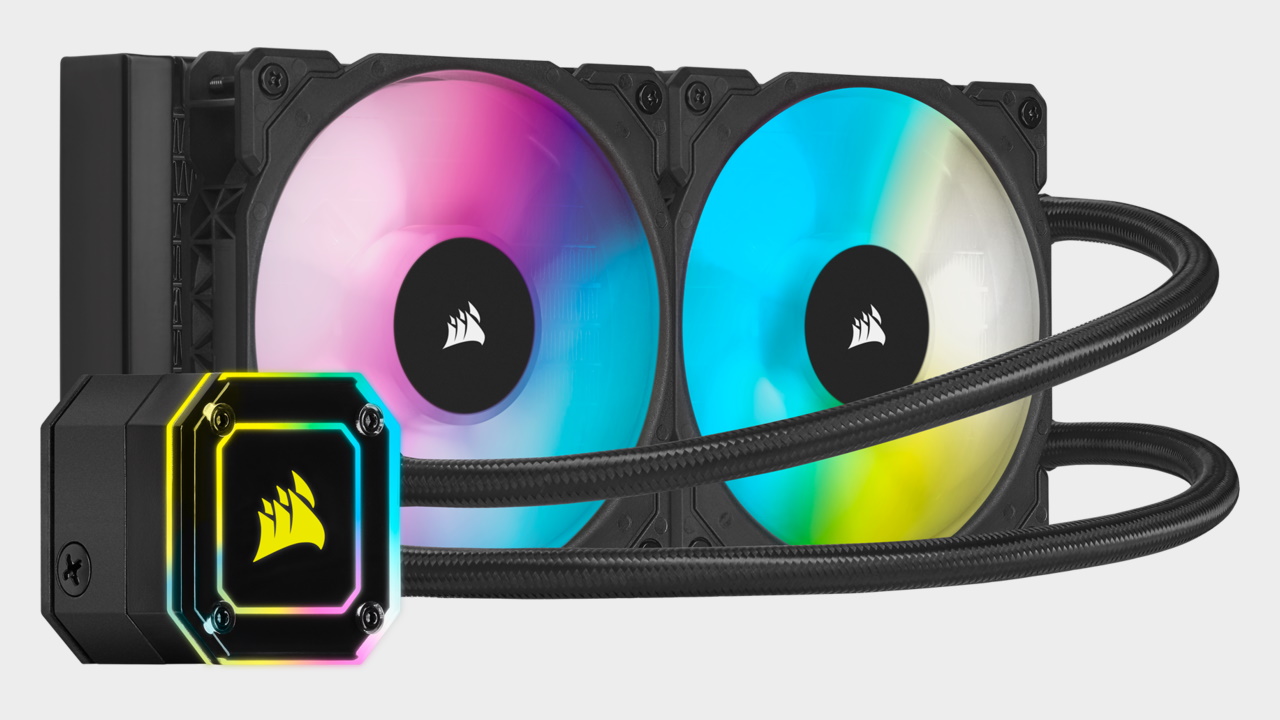Our Verdict
Corsair’s latest AIO liquid cooler combines seriously trick lighting with excellent cooling and noise management. Pity the iCue control software isn’t more reliable.
For
- RGB lighting is killer
- Noise levels are very low
- Excellent cooling capacity
Against
- iCue software is unreliable
- Pump head looks a little dated
PC Gamer's got your back
The iCue H115i Elite Capellix is the latest CPU chiller from Corsair and boy is it colourful. You’d better like lights if you're planning on picking up this all-in-one cooler. This thing has a lot of lights. OK, the RGB functionality is far from the only thing Corsair’s latest all-in-one water cooling solution has going for it. But it is very much central to the proposition.
Radiator: 280mm
Fans: 2x 140mm
Fan speed: 400-2,000rpm
Pump: Centrifugal, 0.82L/min
Lighting: RGB, 33 LEDs in pump, 8 in each fan
Noise: 10–36 dBA
Socket support: Intel LGA 1200, 1150, 1151, 1155, 1156, 1366, 2011, 2066, AMD AM4, AM3, AM2, sTRX4, sTR4
The model currently roasting our retinas is the H115i and thus a 280mm member of a model line also available in 240mm and 360mm form factors. The aforementioned RGB-ness concerns the fans and the top cover of the pump head. The latter comes with an alternative transparent cover if you want to maximize the RGB goodness in that area.
The clever bit, as implied by the wordy moniker, is the use of Corsair’s Capellix LEDs. Corsair reckons they’re not only 90 per cent smaller than conventional LEDs. They’re also more efficient, brighter and run cooler. Add that all up and you have a lighting solution that gives you more mounting options, increased visual impact and fewer downsides and concerns around power use and heat.
The net result is that Corsair has squeezed no fewer than 33 LEDs into the pump head, plus eight per fan. The lighting effects are certainly a clear cut above the RGB normal, with slick transitions and animations and generally a more complex and detailed overall effect. However, the pump head itself looks a little old fashioned, especially compared to the most advanced alternatives such as the NZXT Kraken Z73 with its funky pump-top screen, albeit that’s a much more expensive product.
Anywho, that RGB stuff is controlled by the iCue Commander Core lighting and fan-speed controller box. Along with the pump head, it supports up to six RGB-enabled fans and hooks up neatly to the motherboard via a USB header. Less visually edifying—or physically reassuring, for that matter, is the cable connecting the pump to the motherboard header to initiate operation. It feels fragile and looks cheap.

The other half of the equation is obviously the cooling on offer. Here Corsair has equipped the H115i with a low-noise centrifugal pump with a flow-rate spec of 0.82L/min and a claimed 20dB of noise. The radiator, meanwhile, clocks in at 322x137x27 millimetres and as standard comes with a pair of 140mm mag-lev fans running at speeds from 400 to 2,000rpm.
The full package includes mounting for both Intel and AMD CPU sockets covering all the latest kit. The pump head comes primed with a layer of thermal paste, but there’s no extra tube. So, either bring your own paste or don’t muck the installation up.
Speaking of mucking things up, the instruction booklet is a little light on details and the package labelling, which includes a bag unhelpfully labelled ‘miscellaneous hardware’, could be clearer. But it’s not truly an impediment to assembly. More of an issue, in our kit at least, was the tightness of the screws for attaching the fans to the radiator. They were stiff enough to risk rounding off the heads, which isn’t ideal.
Once up and running, the H115i runs super quiet at idle. In fact, you’ll struggle to detect it with normal hearing. Better still, in even the most extreme performance mode noise levels are extremely well controlled. To give the H115i the most demanding, we tried it out with the flaming inferno that is Intel’s 14nm Core i9-10900K 10-core CPU. The result was tangibly lower temps than several other AIO coolers we’ve test-driven with the 10900K, including the NZXT Kraken Z63. If it’s maximum performance and minimum racket you seek, therefore, you could do an awful lot worse.

At least you could if reliably controlling the Corsair iCue H115i Elite Capellix was a given. In our experience and with the current software and firmware, that’s not quite the case. Initial installation and setup with Corsair’s iCue software went smoothly and the interface offers more RGB configuration options than you could humanly desire.
The cooling configs include quiet, balanced, extreme or zero RPM modes, while the cooling and RGB functionality come together neatly via emergency triggers that can be set to not only ramp-up fan speed but also indicate an issue with an LED colour change when temps blow past a user-defined limit. Nice.
Less edifying is the fact that we had numerous issues with software and driver. After running fully stable at first, a system reboot had the iCue software initially refusing to recognise the cooler was present and then indicating it was present but with a warning symbol and essentially zero functionality. A quick perusal via the world’s de facto search tool suggests ours was not an isolated experience. It seems issues with Corsairs iCue platform are not uncommon. Which is a pity, because we otherwise reckon there’s plenty to appreciate. Assuming, that is, you really do like lights.
Corsair’s latest AIO liquid cooler combines seriously trick lighting with excellent cooling and noise management. Pity the iCue control software isn’t more reliable.

Jeremy has been writing about technology and PCs since the 90nm Netburst era (Google it!) and enjoys nothing more than a serious dissertation on the finer points of monitor input lag and overshoot followed by a forensic examination of advanced lithography. Or maybe he just likes machines that go “ping!” He also has a thing for tennis and cars.


